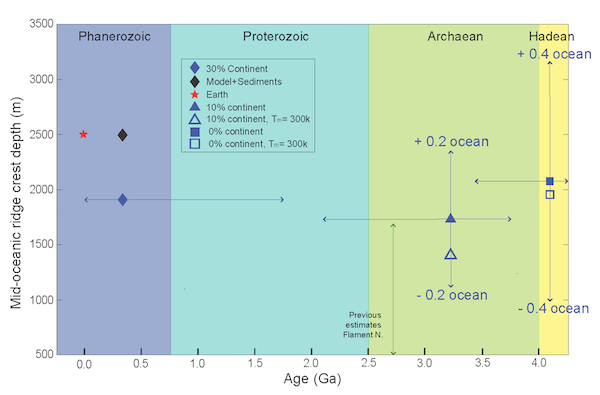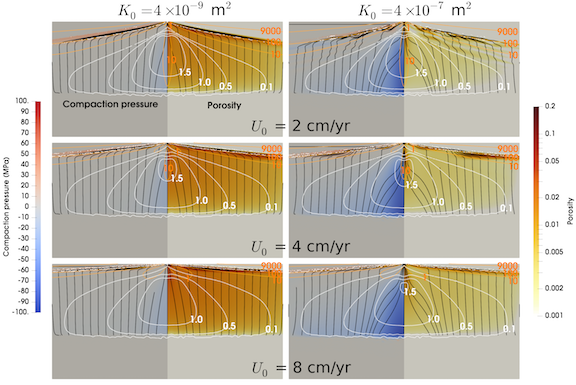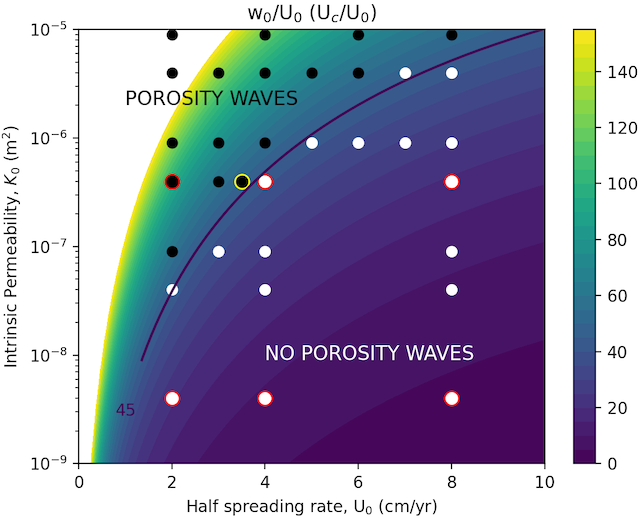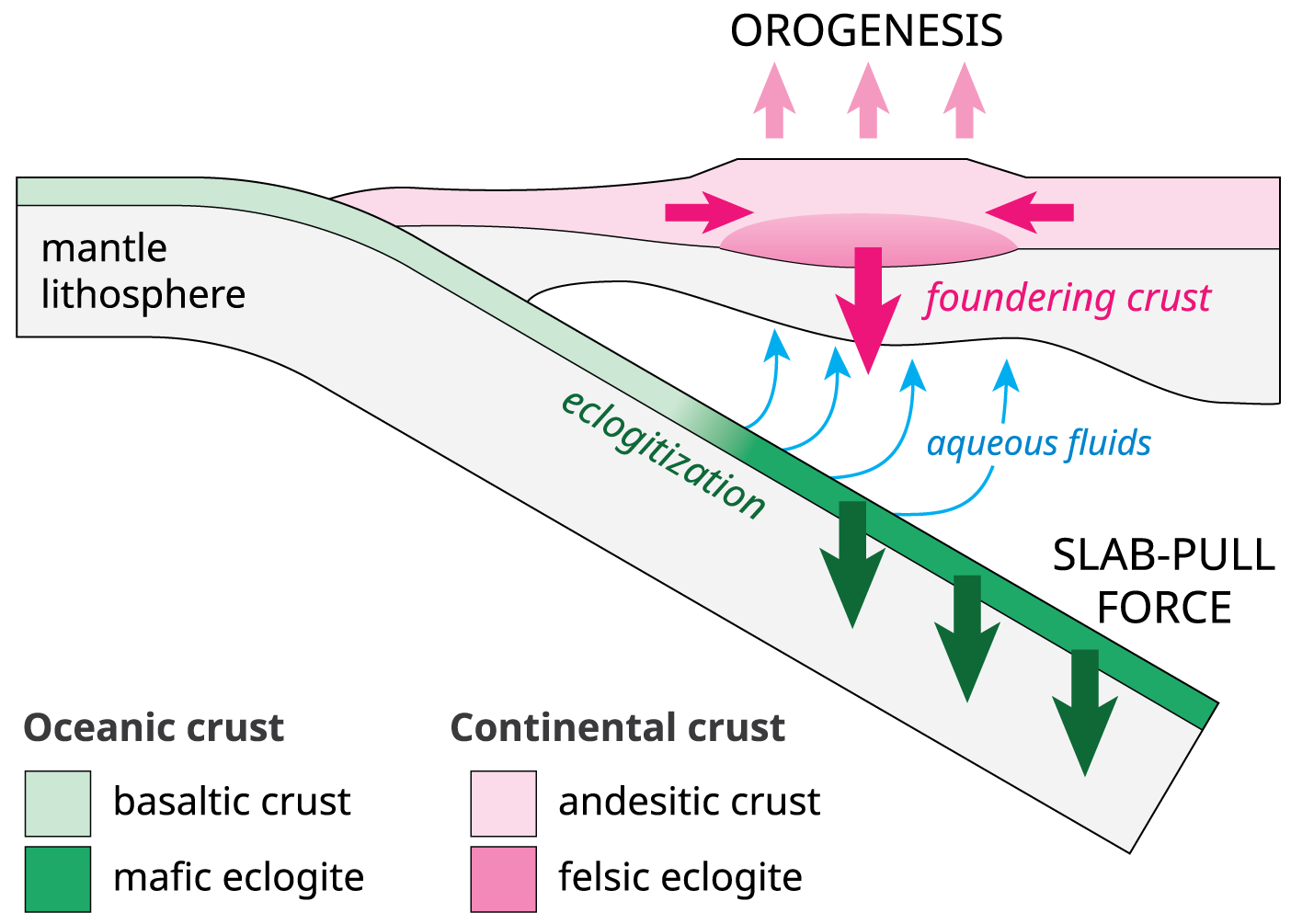Research
Discovery, Education, Innovation
‘Two-phase or not two-phase’
Applying two-phase flow and reactive thermodynamics at tectonic boundaries to understand Earth dynamics through its evolution. Fluid dynamic applications to planetary systems with a goal to understand potential habitability.
Recent abstracts from the group
CIG-TNG Workshop (Breckenridge, CO, 2025)
Quantifying Oxidant Transport via Two-Phase Flow on Europa, C. Pierce-Walker and S. J. Sim.
Exploring mechanisms for localizing eclogite in continental crust with reactive two-phase models, M. McMillan, S. J. Sim, and C. Wilson.
The Influence of Magma Ocean-Atmosphere: Interactions on Volatile Distributions on Early Earth and Venus, B. J. Lopez and S. J. Sim.
Dynamic Habitability: From Mid-ocean ridges to Europa, S. J. Sim.
Mid-ocean ridges

Early Earth
The interconnectedness of life, water, and plate tectonics is strikingly apparent along mid‐ocean ridges (MOR) where communities of organisms flourish off the disequilibrium of chemical potentials created by circulation of hydrothermal fluids driven by Earth’s heat. Moreover, submarine hydrothermal environments may be critical for the emergence of life on Earth. Oceans were likely present in the Hadean but questions remain about early Earth’s global tectonics, including when seafloor spreading began and whether mid‐oceanic ridges were deep enough for maximum hydrothermal activities. For example, plate tectonics influences global sea level by driving secular variations in the volume of ocean basins due to continental growth. Similarly, variations in the distribution of seafloor age and associated subsidence, due to assembly and dispersal of supercontinents, explain the largest sea level variation over the past 140 Myr. Using synthetic plate configurations derived from numerical models of mantle convection appropriate for early Earth, we show that MOR have remained submerged and their depths potentially constant over geologic time. Thus, conditions in the early Earth existed for hydrothermal vents at similar depths as today, providing environments conducive for the development of life and allowing for processes such as hydrothermal alteration of oceanic crust to influence the mantle’s geochemical evolution. [Sim et al 2016].

Melt transport at modern mid-ocean ridges
At mid-ocean ridges, oceanic crust is emplaced in a narrow neovolcanic region on the seafloor, whereas basaltic melt that forms this oceanic crust is generated in a wide region beneath as suggested by a few geophysical surveys. The combined observations suggest that melt generated in a wide region at depths has to be transported horizontally to a small region at the surface. We present results from a suite of two-phase models applied to the mid-ocean ridges, varying half-spreading rate and intrinsic mantle permeability using new openly available models, with the goal of understanding melt focusing beneath mid-ocean ridges and its relevance to the lithosphere-asthenosphere boundary (LAB). Three distinct melt focusing mechanisms are recognized in these models: 1) melting pressure focusing, 2) decompaction layers and 3) ridge suction, of which the first two play dominant roles in focusing melt. All three of these mechanisms exist in the fundamental two phase flow formulation but the manifestation depends largely on the choice of rheological model. The models also show that regardless of spreading rates, the amount of melt and melt transport patterns are sensitive to changes in intrinsic permeability, K0. In these models, the LAB is delineated by the melt-rich decompaction layers, which are essentially defined by the temperature dependent rheological and freezing boundaries. Geophysical observations place the LAB at a steeper incline as compared to the gentler profile suggested by most of our models. The models suggest that one way to reconcile this discrepancy is to have stronger melting pressure focusing mechanism as it is the only mechanism in these models that can focus melt before reaching the typical model thermal LAB. The apparent lack of observable decompaction layers in the geophysical observations hints at the possibility that melting pressure focusing could be significant. These models help improve our understanding of melt focusing beneath mid-ocean ridges and could provide new constraints for mantle rheology and permeability. [Sim et al 2020], Carnegie video highlights for AGU 2019, Geodynamics and Tectonics Virtual Seminar, Invited seminar at University of Maryland, Github repository for model inputs

Porosity waves
Our understanding of oceanic crustal formation is mostly limited to observations of young crust formed in the past several million years, due to the thick sediments on older crust and the remote location of many spreading centers. Here we use 40 m-resolution bathymetric data collected over hundreds of square kilometers during the search for Malaysia Airlines Flight 370 on the flank of the Southeast Indian Ridge, which provides a record of crustal accretion from 11–23 Ma. Spectra calculated from the data show a characteristic timescale of 300–400 kyr and no evidence for periodicity coinciding with glacial cycles. This characteristic timescale could be explained by fluctuations in melt supply and the amount of faulting, leading to variations in crustal thickness. We show that this timescale of variation is consistent with porosity waves observed in a two-phase flow model, which persist over millions of years. [Parnell-Turner, Sim and Olive 2020]

The ocean floor makes up the majority of the Earth’s surface and yet, its geomorphology is not fully understood. Recent debate has focused on whether sea level changes—driven by Milankovitch glacial cycles—generate the abyssal hill fabric of the ocean floor by modulating mid-ocean ridge magma supply. However, periodicities longer than Milankovitch cycles are prominent in the ocean bathymetry. Using crustal thickness estimates from two-phase flow simulations of ridge magma transport, I show that persistent melt-rich porosity waves could be responsible for the ocean floor fabric at periods of 100 kyr and longer, except in the case of fast-spreading ridges. For periods longer than 100 kyr, spectral energy is notably present at large mantle permeabilities regardless of spreading rates. Therefore, two-phase flow models can provide constraints on elusive mantle parameters such as permeability and viscosity when directly linked to the ocean floor fabric produced. Sim 2022
Subduction zones
Carbon potential at subduction zones
In the deep carbon cycle, the largest contributor of CO2 to the atmosphere are both diffused and concentrated emissions from the subduction zone system. The changing amount of CO2 in the atmosphere affects long term global climate that may be a positive feedback mechanism with tectonic activities. The main potential source for carbon emitted in the arc system is carbonate that enters the subduction zone as seafloor sediments and altered ocean crust. The traditional view of the fate of this carbon after subduction is that most of it is carried into the deep mantle past the subduction zone, due to its high decarbonation temperature and predicted low solubility in H2O-rich fluids. However, recent experimental and thermodynamic modeling of carbon solubility in aqueous fluids at high pressure and temperature settings suggest that a substantial amount of carbon can be carried by aqueous fluids released from the oceanic lithosphere. In this work, we use the carbon solubility model from Kelemen & Manning 2015 (based on DEW, Sverjensky et al 2014) and apply it to a global suite of subduction zone convection models with the goal of understanding the the potential for carbon storage in the mantle wedge. The results presented give us an idea of where carbon species might be dissolved, deposited or stored as aqueous fluids released from the subducting slab move through the mantle wedge. Carnegie video highlights for AGU 2019
Eclogitization of continental lithosphere from subduction zone devolatilization

Subduction zones are regions where one tectonic plate collide and is forced beneath another plate, resulting in natural hazards like earthquakes and volcanic eruptions along with mountain building (orogenesis). Where the continental crust is thick, foundering or the removal of the lower crust can sometimes occur due to a phase change (eclogitization) that makes it denser than the surrounding and therefore unstable. Regional metamorphism and densification (eclogitization) of the lower crust can affect the lithospheric dynamics of mountain belts, but the coupled effects of reaction rate, temperature, and composition on metamorphism are poorly understood. We present a reactive thermodynamic model of the granulite–eclogite transition to investigate the long-term buoyancy and gravitational stability of the lower crust. First, we characterize the conditions for which orogenic crust attains negative buoyancy by determining its reactive mineral assemblage and density under prescribed pressure–temperature–time paths. Using existing metamorphic rate data, we calibrate a Damko"hler number (a relative reaction rate) to parameterize the catalytic effect of aqueous fluids. The depth necessary for negative buoyancy is sensitive to temperature and Da, ranging from about 45-70 km for a basaltic-andesite composition (54 wt.\% $SiO_2$). Second, using a Rayleigh–Taylor instability analysis, we suggest that, while cold eclogitic crusts would be strong enough to resist foundering within 50 Myr, warm crusts could obtain large thicknesses of about 10-30 km and would founder within 50 Myr. We hypothesize that such foundering events are a natural consequence of convergent tectonics, where the aqueous fluids and high pressures required for metamorphism are known to exist. The Pampean flat slab in the Central Andes provides geophysical evidence linking slab fluids to eclogitization and densification of the thickened continental crust. Lithospheric foundering coupled to convergent tectonics through eclogitization could explain many observations of orogenic hinterland deformation and magmatism. Next, we couple this reactive thermodynamic model to fluid transport to recreate the observations of Norwegian eclogites. McMillan et al, 2025
Resolving the effects of lithospheric foundering on mountain building: An example from the southern Puna plateau, Argentina
Earth’s largest mountain belts and high plateaus are supported by thick, buoyant crust and an anomalous lack of dense lower crust and mantle lithosphere. This project will investigate the processes by which the lower crust and lithosphere are removed by sinking, known as foundering, and the imprint of such processes on the geologic record. The work will focus on the southern Puna plateau, NW Argentina, where multiple lithosphere removal events are hypothesized from geological, geophysical, and geochemical datasets. By pairing dense geological datasets with numerical modeling results, the project will test the geological evidence and physical feasibility of hypothesized modes of lithosphere removal. The Puna plateau preserves a unique sedimentary record of Cenozoic mountain-building, and Miocene lithospheric foundering has long been proposed from geophysical and geochemical datasets. Recent studies suggest foundering as an explanation for anomalous Miocene subsidence/shortening and uplift/extension of the Arizaro and Antofalla Basins, respectively, ~150 km apart. The opposite senses of deformation associated with these potential foundering events suggests that foundering may induce highly diverse modes of deformation in the overlying crust, potentially controlled by the thermal, compositional, or structural state of the crust. We will undertake a multi-disciplinary study using geologic mapping, measured stratigraphic sections, and geo- and thermochronology to better constrain the spatial-temporal distribution of deformation and subsidence in the southern Puna plateau, as well as cutting-edge numerical modeling to characterize controls on foundering style or other processes that may have driven deformation in the region. This integrated approach will allow rigorous testing of whether foundering is consistent with observations from the Antofalla and Arizaro Basins, and if so, what crustal parameters control the effects of foundering.
Cryosphere and planetary systems

Exfiltration of ground water beneath thinning Antarctic ice sheets
The two-phase flow formulation applies to many environments including the icy poles on Earth and water worlds. Collaborations at GeorgiaTech has led to the understanding of the potential for groundwater exfiltration beneath the thinning Antarctic ice sheets. Groundwater-laden sedimentary aquifers are extensive beneath large portions of the Greenland and Antarctic ice sheets. With a simple theory, it is shown that as the ice sheets thin, there is a potential for exfiltration that can be a dominant component of the subglacial water budget. Continued Antarctic Ice Sheet thinning over the coming decades to centuries guarantees that the role of exfiltration in the basal water budget will only continue to grow into the future, suggesting the need to develop better integrated models of interactions between subglacial groundwater and drainage. Robel et al, 2023

Melt water transport in icy shell of ocean worlds to understand potential habitability
Similar to ice on Earth, there are icy environments in other planetary systems such as on the moons of Jupiter, Ganymede or Europa. NASA Europa Clipper Mission has a launch date on October 2024 and will reach Jupiter orbit around 2030. Europa has diameter about a quarter that of Earth but has a relatively sizable water body that has been hypothesized to potentially host life. Europa has an icy surface estimated to be around 3-30km thick with an liquid salty ocean beneath followed by a rocky floor. The icy surface layer has been hypothesized to transport materials between the ocean and the surface in various ways including two-phase flow transport briny water. We aim to simulate this transport in the hopes to better understand this exchange and help guide the Clipper mission.

Volatile trapping during magma ocean crystallization on Mars
Immediately following core formation on Mars, the planet underwent a magma ocean (MO) phase. Volatiles released from the MO fostered a primitive atmosphere (PA) which modulated heat loss from the cooling planet through the greenhouse effect. The solidification and degassing of the MO are therefore coupled. In this work, we investigate two important aspects of this evolution: 1) the dynamics of melt trapping at the freezing front of the residual mantle (RM) and 2) the oxidation state during crystallization. For crystallization rates applicable to the martian MO, compaction is inefficient, leading to large fractions of melt trapped together with the crystals accumulating in the RM. The $H_2O$ content of the martian RM is strongly influenced by dynamic melt trapping. Following MO crystallization, up to 55.4% of the initial $H_2O$ in the MO is sequestered in the RM, with the rest outgassed to the surface. Dynamic melt trapping also limits variations in trace element concentrations and fractionations. Resulting variations in important isotopic parent/daughter ratios (Sm/Nd, Lu/Hf) cannot account for all of the isotopic diversity inferred for martian basalt source regions, hence requiring alternative mechanisms. The redox state of the MO exerts a strong control on the total $CO_2$ content of the RM and the time of crystallization. Under oxidizing conditions, the residual mantle stores 0.01% of the delivered $CO_2$ but under the most reducing conditions we examined, the residual mantle can sequester 80.4% in the form of trapped carbonated melt and graphite/diamond. Sim et. al., 2024, LPSC 2024, virtual seminar at Zhejiang University
Resources
- The Declaration on Research Assessment (DORA)
- Subduction Zone initiation database
- Atlas of the Underworld: Slab
- Scientific colormaps
- Large Igneous Provinces database
Software
- TerraFERMA (FEM PDE)
- FEniCS Project (FEM)
- PETSc (Parallel solvers)
- Gmsh (mesh)
- Cubit (mesh)
- G-Adopt (adjoint)
- Firedrake (FEM PDE)
- PlotDigitizer
- BurnMan: a thermoelastic and thermodynamic toolkit for the Earth and Planetary Sciences
- Perple_X
- Thermocalc
- ThermoCodegen
- NASA: Eyes on the solar system
- Submap: tool for plotting subduction zones
- USGS Slab 2.0
- GPU - openACC
Organizations
- Computational Infrastructure for Geodynamics (CIG)
- American Geophysical Union (AGU)
- European Geophysical Union (EGU) Geodynamics
- Extreme Science and Engineering Discovery Environment (XSEDE) (Retired - Now ACCESS)
- Advanced Cyberinfrastructure Coordination Ecosystem: Services & Support (ACCESS)
- National Science Foundation (NSF), NSF Resource Center, NSF Active CSEDI Awards
- National Aeronautics and Space Administration (NASA)
- Subduction Zone 4D (SZ4D)
- Volcanology Infrastructure for Computational Tools and Resources (VICTOR),VICTOR software
- US InterRidge
- Europlanet
Instruction
- Science Education Resource Center (SERC) at Carleton College
- Teach the Earth at Carleton College
- Center for Teaching and Learning (CTL) at Georgia Tech
- The Chronicle of Higher Education
- Center for the Integration of Research, Teaching and Learning (CIRTL)
Workshops
Seminars
- Georgia Tech EAS Solid Earth seminar
- Georgia Tech EAS departmental seminar
- Virtual Seminar in Precambrian Geology (VS-PG) Seminar
- Zhejiang Virtual Seminar
- GFZ Rift Seminar
Lectures/Tutorials/Articles
- 50 years of Plate Tectonics: Parisian Collège de France 2018, Lamont 2016, Geological Society
- ADVANCEGeo: Empowering (geo)scientists to transform workplace climate
- National Parks and Plate Tectonics
- URGE: Unlearning Racism in Geosciences
- XSEDE Video tutorials
- Intro to HPC
- Georgia Tech Vertical Integrated Project HPC
- Scientific Colormaps
- “Consistent Thermo- and Geo-dynamics” by Cian Wilson, Carnegie Science
- Nature Racism special issue
- Melt in the Mantle workshop lectures
- SZ4D webinar
- Field Safety, SERC field safety, Field safety plan for NSF, Report of the Workshop to Promote Safety in Field Sciences, example
- Earth Science coding by Prof Alex Robel
Writing
- Coursera: Writing in the Sciences (Stanford)
- Writing Effectively
- Nature article to Graduate student on writing
Art/Outreach/Other fun stuff
- Did this really happen comics
- Science.Art.Wonder!
- Math Magazine by 8th Grader Mary Jones
- PROGRESS Pathways Panel, PROGRESS (PROmoting Geoscience, Research, Education and SuccesS) Program
- National academies mentoring for STEMM resources
- GT Campus Cats
- Scientists in Parks fellowship
- XKCD in matplotlib


